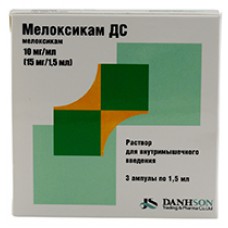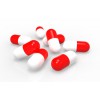Expiration date: 10/2026
Form release
The solution for intramuscular introduction
Composition
1 ml contains: meloxicam 10.00 mg/ml.
Auxiliary substances: glycine (aminouxusna acid), macrogol (polyethylene glycol 400), meglumine (N-methyl-D-glucamine), povidone-17 (plasdone–15 or kollidon 17 F), 1.2 — propylene glycol, sodium hydroxide, water for injections.
Packaging
Pack of 3 and 5 ampoules of 1.5 ml
Pharmacological action
Meloxicam is a nonsteroidal anti-inflammatory drug (NSAID), has anti-inflammatory, antipyretic, analgesic effect. Belongs to the class of oxicam derived anoliefo acid. Mechanism of action — inhibition of synthesis of prostaglandins (Pg) by the selective suppression of the enzymatic activity of cyclooxygenase 2 (COG2). When administered in high doses, prolonged use and individual characteristics of the organism COG2 selectivity decreases. Inhibits synthesis of Pg in the field of inflammation to a greater extent than in the mucous membrane of the stomach or kidney, which is associated with a relatively selective inhibition COG2. Less common causes of erosive and ulcerative diseases of the gastrointestinal tract (GIT).
Indications
Rheumatoid arthritis, osteoarthritis, ankylosing spondylitis (Bechterew's disease) and other inflammatory and degenerative diseases of the joints, accompanied by pain syndrome.
Contraindications
Hypersensitivity (including to other NSAIDs), combination of bronchial asthma, recurrent polyposis of the nose and paranasal sinuses and intolerance of acetylsalicylic acid (ASA) and the medicines pirazolonovogo number, peptic ulcer and 12 duodenal ulcer (in acute phase), severe liver failure, chronic renal failure (CRF) patients not undergoing dialysis (creatinine clearance (CC) less than 30 ml/min), active gastrointestinal bleeding, progressive kidney disease, severe hepatic insufficiency or active liver disease status after conducting coronary artery bypass surgery, confirmed by hyperkalemia. inflammatory bowel disease, children's age (under 15 years), pregnancy, lactation.
With caution: advanced age, ischemic heart disease (IHD), chronic heart failure (CHF). cerebrovascular diseases, dyslipidemia/hyperlipidemia, diabetes mellitus, peripheral artery disease, Smoking, KK less 60 ml/min ulcerative lesions of the gastrointestinal tract in the anamnesis, infection with N. pylori, prolonged use of NSAIDs, alcoholism, severe somatic diseases, simultaneous administration of oral glucocorticoid drugs (GCS) (including prednisone), anticoagulants (including warfarin). antiplatelet agents (including clopidogrel), selective inhibitors of reverse takeover serotonin (including citalopram, fluoxetine, paroxetine. sertraline's.)
Application of pregnancy and breastfeeding
Contraindicated during pregnancy and lactation.
Method of application and doses
Intramuscular Meloxicam is advisable during the first 2-3 days of treatment. In the future, you should go to the reception of the drug inside.
The recommended dose of Meloxicam for injection is 7.5 mg or 15 mg/day. depending on the intensity of pain and the inflammatory process. The maximum recommended daily dose should not exceed 15 mg.
In patients with chronic renal failure severe, hemodialysis dose of Meloxicam should not exceed 7.5 mg/day.
Given that the dose regime for children and adolescents under the age of 15 is not installed. Meloxicam is prescribed only for adults and adolescents over 15 years.
Meloxicam should be administered by deep intramuscular injection. It should not be used intravenously.
Special instruction
In the occurrence of peptic ulcers or gastrointestinal bleeding, development of side effects in the skin and mucous membranes, the drug should be discontinued.
In patients with a reduced volume of circulating blood (BCC) and reduced glomerular filtration (dehydration, CHF. liver cirrhosis, nephrotic syndrome, symptomatic kidney disease, diuretics, dehydration after major surgery), you may receive clinically significant CRF. which is fully reversible after discontinuation of the drug (in these patients, early treatment should be monitored daily diuresis and renal function). The steady and significant increase in transaminases and changes in other indicators of liver function the drug should be discontinued and conduct control tests. In patients with an increased risk of side effects, the treatment begins with a dose of 7.5 mg In ESRD patients undergoing dialysis, the dose should not exceed 7.5 mg/day. During the period of treatment must be careful when driving and occupation of other potentially hazardous activities, require high concentration and psychomotor speed reactions (if you experience dizziness and drowsiness). To reduce the risk of adverse effects from the blood should use the minimum effective dose minimum possible short course.
Overdose
Symptoms: violation of consciousness, bleeding from the gastrointestinal tract, acute renal failure.
Treatment: no specific antidotes, symptomatic therapy. Interaction with other drugs
At simultaneous reception with other NSAIDs increases the risk of ulcers and gastrointestinal bleeding.
With simultaneous use of NSAIDs with lithium drugs increases the concentration of lithium ions in blood plasma by reducing renal excretion of lithium. If necessary, such combined therapy is recommended to monitor the level of lithium ions in blood plasma at the beginning of treatment, the selection of doses and the abolition of meloxicam.
Meloxicam reduces the effectiveness of intrauterine contraceptive devices (IUD). antihypertensive drugs. Indirect anticoagulants, tiklopidin, heparin, thrombolytics increase risk of bleeding. Methotrexate enhances the myelodepressive effect, diuretics increase risk of renal dysfunction and cyclosporine increases nefrotoksicescoe effects, cholestyramine accelerates the elimination. Myelotoxic drugs increase the manifestation gematotoksichnosti drug.
Storage conditions
Keep at temperature not exceeding 25 °C.
Shelf life
3 years.





